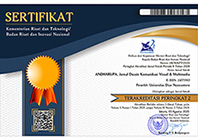Perancangan Font Tapych Berbasis Karakter Visual Motif Tapis Lampung
DOI:
https://doi.org/10.33633/andharupa.v3i01.1260Abstract
Abstrak Tapis merupakan kain khas asal Lampung yang terbuat dari tenunan benang kapas berwarna emas dan perak. Sebagai produk budaya, tapis memiliki visualisasi yang khas. Berdasarkan observasi, pemanfaatan tapis yang memiliki representasi nilai dan nilai estetika tinggi masih terbatas pada media dan waktu tertentu. Hal ini tentu saja menimbulkan kekhawatiran tentang pelestarian dan pengembangan tapis karena keterbatasan pemanfaatannya. Contoh pemanfaatan tapis yang dapat dilakukan adalah upaya eksplorasi visual kedalam bentuk produk budaya lain yang lekat dengan keseharian masyarakat. Salah satu produk budaya yang dapat dirancang adalah huruf. Huruf merupakan media komunikasi tulisan yang sebenarnya telah lama ada dan berkembang. Di Indonesia, komunikasi tulisan mayoritas menggunakan huruf latin. Penggunaan huruf latin di Indonesia dapat dilihat mulai dari cara manual hingga sudah dilakukan secara digital. Huruf digital atau disebut dengan font saat ini banyak digunakan pada perangkat-perangkat digital/elektronik. Perkembangan desain font juga terus berkembang karena kebutuhan akan penyampaian pesan maupun kesan estetis pada suatu karya juga berkembang. Hal inilah yang kemudian menginspirasi lahirnya kemungkinan-kemungkinan bentuk visual baru font khususnya yang berbasis huruf Latin. Tapis, dengan kekayaan estetik pada visualnya dapat dijadikan sebagai inspirasi dalam menciptakan kemungkinan bentuk baru dari sebuah font yang berbasis pada bentuk huruf latin. Perpaduan visual antara tapis dan karakter huruf latin dapat menghasilkan karakteristik yang khas.  Kata Kunci: Adaptasi, Font, Perancangan, Tapis, Visual  Abstract Tapis from Lampung is a unique fabric made from cotton yarn woven gold and silver. As cultural products, Tapis have a typical visualization. Based on observations, the use of Tapis which has a value of representation and a high aesthetic value is still limited to the media and a certain time. This raises concerns about the preservation and development of the Tapis due to the limited utilization. Examples of the use of Tapis that can be done is a visual exploration efforts into other forms of cultural products attached to everyday people. A cultural product that can be designed is the letter. Letter is a medium of communication that has long been there and growing. In Indonesia, the majority of written communications using Latin letters. The use of the Latin alphabet in Indonesia can be seen from how the user until it is done digitally. Digital letter or called by the current font is widely used in digital devices / electronic. Font design development is also growing because of the need for the delivery of messages as well as the growth of aesthetic impression. This inspired the birth of the possibilities of new visual font forms especially based Latin letters. Tapis, with the wealth of the visual aesthetic can be used as inspiration in creating the possibility of a new font form based. Visual fusion between Tapi and the Latin alphabet characters can produce distinct characteristics.  Keywords: Adaptation, Fonts, Design, Tapis, VisualReferences
Sihombing, Danton. (2003). Tipografi dalam Desain Grafis. Jakarta: PT. Gramedia Pustaka Utama.
Rustan, Surianto. (2011). Hurufontipografi. Jakarta: PT. Gramedia Pustaka Utama.
Dinata AR, Artha. (2008). Kain Tapis Lampung. Dikutip dari https://arthaliwa.wordpress.com/2008/12/14/kain-tapis-lampung/(Diakses 26/04/2015).
Ramadhan, Bagus. (2015). Keindahan Kain Tenun Tapis dari Lampung. Dikutip dari https://www.goodnewsfromindonesia.org/2015/09/09/keindahan-kain-tenun-tapis-dari-lampung (Diakses 05/08/2016)
Downloads
Published
Issue
Section
License
Copyright (c) 2017 ANDHARUPA: Jurnal Desain Komunikasi Visual & Multimedia

This work is licensed under a Creative Commons Attribution 4.0 International License.
Authors who publish with this journal agree to the following terms:
- Authors retain copyright and grant the journal right of first publication with the work simultaneously licensed under a Creative Commons Attribution License that allows others to share the work with an acknowledgment of the work's authorship and initial publication in this journal.
- Authors are able to enter into separate, additional contractual arrangements for the non-exclusive distribution of the journal's published version of the work (e.g., post it to an institutional repository or publish it in a book), with an acknowledgment of its initial publication in this journal.
- Authors are permitted and encouraged to post their work online (e.g., in institutional repositories or on their website) prior to and during the submission process, as it can lead to productive exchanges, as well as earlier and greater citation of published work (See The Effect of Open Access).















